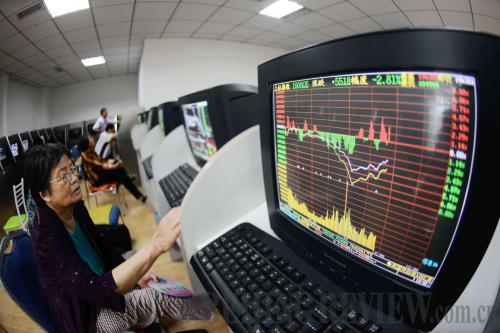|
 |
|
ON TENTERHOOKS: An investor keeps a close eye on the stock market in a securities exchange in Qingdao, Shandong Province, on June 25 (XINHUA) |
Chinese portfolio investors may never forget PetroChina Co. Ltd.'s initial public offerings (IPO). On November 5, 2007, PetroChina was listed on the Shanghai Stock Exchange as the most profitable company in Asia. Its IPO price was 16.7 yuan ($2.71), but shares opened at 48.6 yuan ($7.88) on the first day of trading. The resplendent financial figures attracted flocks of investors. But two days later, its stock price began its long downturn. The stock price fell below the offering price of 16.7 yuan a year later, and on June 27, its stock price only stood at 7.36 yuan ($1.2).
Chinese securities experts, media and investors at the time blamed China's immature IPO market for causing the stock's nose-dive.
To strengthen the country's stock market, the China Securities Regulatory Commission (CSRC) issued new IPO draft rules on June 7 to collect public opinion until June 21, after which the rules would come into effect and allow for new listings to resume after they were suspended seven months ago.
Problems
China's stock market has a history of only 20 years. The present IPO mechanism began on January 1, 2005, when a quasi-market-oriented approach was adopted. The IPO needed examination and approval while the market decided stock prices. That is to say, whether a company can be listed on the stock market is approved by the CSRC, but the IPO prices are decided by issuance institutions through competitive means.
Wang Yong, a researcher with CITIC Securities Co. Ltd., says such a quasi-market-oriented mechanism causes high IPO prices, high price-to-earnings ratio and high IPO capital. Almost all the new stocks in China face the three "highs," which usually result in unreal stock prices and damage investor interests.
The most serious problem is fraud, says Wang. To get listed, some companies fake financial figures in order to pass CSRC scrutiny. Moreover, during the IPO process, the issuers and underwriters both hope for an over-subscription of shares, because underwriters can get higher underwriting fees while the issuers and private equity institutions can cashout at higher prices after the IPO. Therefore the issuers, securities companies and private equity institutional investors are likely to be in cahoots with each other. However, Chinese law has no provisions on the legal liabilities of IPO underwriters and issuers.
"The problems in the IPO and pricing process are due to an immature system which cannot meet the demands of market development. But the root cause is that the present IPO mechanism is not yet thoroughly market-oriented," said Wang.
Market-oriented
According to a CSRC statement, the reforms are aimed at enhancing the obligations of issuers and holding shareholders, making the pricing process of new shares more market-oriented and strengthening supervision and law enforcement.
In its draft document, the CSRC proposed that the timing of the IPO should be decided by the issuer and its underwriters in accordance with market conditions, and the IPO process should be controlled by the market itself instead of being decided by the CSRC and stock exchanges.
Furthermore, the draft prospectus of a company will be disclosed on the CSRC's website after being accepted by the commission. A company whose IPO application is being examined can issue corporate bonds first. The CSRC will explore and encourage companies to issue other forms of stock rights other than common stocks or finance in the form of combining stocks and bonds. After an issuer passes the procedures of the CSRC's Public Offering Review Committee, the CSRC will approve its IPO and the issuer can decide the timing of the IPO within 12 months of approval.
| 